|
The
Hallicrafters S-120
Radio Project OR How I finally got my birthday present to work the way I always wanted it to after 50 years. A comprehensive story containing historical, educational, technical and biographical elements & opinions by John Fuhring How I got my S-120 I was given
this radio for my 16th birthday in December of 1961 because I was
always talking about shortwave radios and my parents wanted to give me
something nice. These radios were considered "inexpensive general
coverage receivers," however since they were hand built and hand wired,
they cost a lot of money, about $70 in 1960 dollars or about $400 in
today's money. They were fine for short wave broadcast and AM
radio listening, but they were pretty useless as Amateur band
radios because of their lack of selectivity and stability and, most
importantly, they had a very poor beat frequency oscillator (BFO).
They also used a simple diode detector rather than a
more
complicated and effective product
detector for producing audio. I'm sure my folks thought they were
buying me a "ham
radio" and were probably told that by the salesman who sold it to them.
When I first received this radio, I was pleased with it, but it was no ham radio. I soon discovered that it really wasn't up to the crowded conditions on the ham bands and the BFO made listening to Morse Code (AKA, Continuous Wave, AKA, CW) nearly impossible. Trying to listen to Single Side Band (SSB) ham radio broadcasts with that BFO was definitely impossible. Still, I was thrilled to be able to hear all the international short wave broadcasts and with its help, I learned something about the wide world outside my isolated little town.  My old S-120 as it looks today
which is about the same as it looked in 1960.
When I first got my S-120, Radio Havana was one
of the first stations I tuned in to because it was on every day and it
came in loud and clear and it was in English. Castro's Cuban
Revolution
had just
occurred and I listened with shock and anger as Radio Havana
broadcasted what I thought was needlessly hostile and hateful
anti-American
propaganda. I
have since come to realize that much of what was broadcast by Radio
Havana was simply the truth regarding our dirty
dealings
down there starting in 1898 when we took Cuba from the Spanish and then
made it a haven for our organized crime bosses. Why hell,
we still "own" a beautiful bay right on their own soil where the worst
kinds of violations of our own Constitution are practiced on people who
don't even have the right to a trial. I've got more to say on this in a little
rant at the very end of this article if you are so interested.
Getting my S-120 to
work the way I wanted it
After high
school I sort of let my interest in
short wave radio wain and I stopped
using the radio. Earlier I had grown increasingly dissatisfied
with my S-120
because the upper band
(band 4) never did work, audio
amplifier tubes kept overheating and burning out and the radio's very
unstable Beat Frequency
Oscillator (BFO) operation
irritated me. A lot of water went under the bridge and a lot of
things happened in my life for good and bad, and for about 40 years,
right up until last year, the
radio sat around my
house gathering dust and serving strictly as a piece of decoration.
Still,
I knew
that "someday" I'd really fix the radio up and listen to it once again.
Probably the biggest reason I waited so long before taking it on
as a project was because I had no
schematic to work to. The Internet changed all that and now
schematics are available for nearly every radio ever made. The Hallicrafters S-120 schematic
after a clean-up. This is the schematic I recommend you use
to rebuild your radio to. There aren't that many parts, there is plenty of work room and the job goes quickly. I recommend changing the plug to a polarized one and be sure to hard wire the AC Neutral wire to the return bus as shown in the larger schematic. There is a link to a larger version of this schematic at the end of this page. A few months ago I downloaded the original schematic and then went to work on it so that I'd have something readable to work to and to record the modifications I wanted to make. The result is the schematic shown above. I cleaned it up with the Paint program and with the help of this schematic, I finally began working on the old radio. I replaced the electrolytic capacitors, of course, but all the rest of the capacitors and resistors were of a modern type and I left them in except for one very important capacitor.* I was especially pleased to discovered that a leaky coupling capacitor between the first audio amplifier and the output amplifier was the reason the amplifier tubes used to overheated and burn out. The leaky capacitor put a positive bias on the grid and caused too much current to flow in the tube, thus overheating it. The upper band problem that had disappointed me as a kid was fixed when I found a bad connection on the band selector wafer switch and fixed it. * Since writing that, I have discovered that the capacitors in the S-120 are not modern types after all. They look modern because they have a plastic shell on them, but are really the old fashioned paper-foil types that can cause future trouble. As of now, I am of the opinion that ALL the capacitors except C21, C22, C23, C14 and C17 should be replaced with modern capacitors. In some radios, C14, C17, C18, R12 and R13 are all molded together in a block called a "couplate." Lately I've helped people with their radios and many times their problems resided in their couplate. If you have one in your radio, get rid of it immediately and replace it with discrete components. Couplates are a cheap device that were made to save a buck or two, but they are complete junk and a source of real trouble. Another problem these radios (and later S-38 models) are subject to is the dreaded "Silver Mica Disease." The IF cans contain a built-in, non-sealed, silver mica capacitor that after all this time can migrate silver oxide to where it shouldn't be. This migration of highly conductive silver oxide causes the capacitors to "break down" under the B+ voltage and produce a terrible crashing sound in the speaker. If your radio has this crashing sound on all bands and you have replaced the couplate, it is very likely that one or both of your IF cans has "Silver Mica Disease," but don't despair. It is a bit of a pain, but the cans can be removed, disassembled, the offending capacitors removed and then reassembled with new capacitors. Some people put the new capacitors inside the cans, but other people choose to put them in externally. There are several excellent websites that show you exactly how to "cure" Silver Mica Disease, so I won't "reinvent the wheel" here.  Once you have your radio restored and working well, you might consider adding a "real" BFO such as I did to my radio. The little FET BFO module works very much better than the IF oscillation BFO of the original design. This schematic also shows the return bus hard wired to AC Neutral There is a link to a larger version of this schematic at the end of this page.
Finally, I solved the
awful BFO problem
by building and installing a "real" BFO oscillator that works
beautifully, really beautifully and having it is a huge, huge
improvement over
the otherwise
useless BFO my radio used to have. In the diagram, note the tiny
Field Effect Transistor (FET) BFO
circuit in the
center of
the
schematic and below the 12BA6 tube. I built the new BFO
circuit using a MFP-102 field effect transistor and a coil I
wound on a small toroidal
form with all the parts mounted on a tiny terminal strip. The BFO is
powered
by +6 volts
from the audio output tube's cathode
biasing resistor. The BFO's output is very lightly coupled to the
grid (pin 1) of
the 12BA6 IF tube by simply having the wire from the BFO next to the
wire going to the grid (too much coupling will swamp the IF tube).
The BFO circuit draws just a few microamps so it has
no effect on
the bias of the audio output tube. This is the same BFO design I
used
in the S-38b radio and it works as well here as it does in that radio.
For a more detailed explanation of how these little BFO's work with the simple AM diode detectors found in these radios, please read the BFO section of my EC-1 page. By the way, Here is a useful tip from my EC-1b page: One really great way to find broadcast stations on the shortwave bands is to turn on the BFO and listen for loud "whistles" as you tune up and down the dial with the main tuning control. When you hear a whistle, tune as close to "zero beat" as possible and then turn off the BFO. Trim up the signal with the bandspread control and you have a nicely tuned in shortwave station to listen to. For me, this is probably the most useful thing a BFO does.  Here's a closeup of the IF stage showing the new BFO in more detail. Note that R6 is used simply as an on/off switch and should be either fully clockwise (on) or fully counterclockwise (off).  Here is what the module looks like soldered to the back side of the chassis. See how simple it is and how easily it fits into the radio? These things can also be made on small chips of perf-board and mounted with lugs. 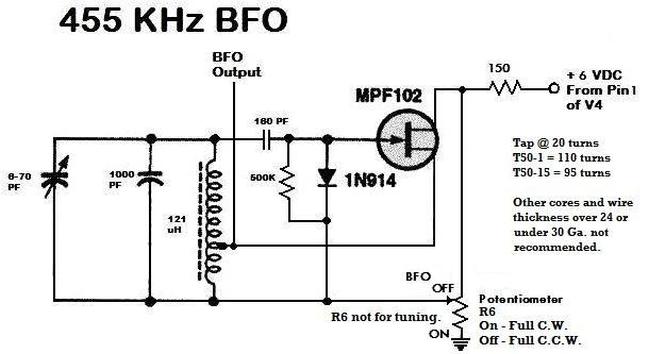
An Alternative design a reader suggested
As with my other radio projects, I wanted to make sure this was a safe radio and that I wouldn't get an electrical shock from it while working on it. I studied the schematic very carefully and I saw that, unlike some of the earlier Hallicrafters radios (like the EC-1s and the S38s), the S120's chassis was already adequately safe because it was originally designed with an isolated return bus and the chassis was not connected directly to AC. Just to give it an added safety factor, I installed a polarized AC plug and connected the return bus (not the chassis) to AC neutral. Unless you do this, you have a 50/50 chance of getting a slight shock from the radio as a small AC current may flow from the return bus through the 0.047 mF bypass capacitor and 470K Ohm resistor to the chassis. Such a shock wouldn't be dangerous, but it could startle you and maybe cause you to hurt yourself or damage the radio.  Another change I made to the radio was to bypass the original selenium high voltage rectifier with a tiny silicone diode. All I did was to simply solder the diode across the selenium's electrodes while making sure I had the polarity correct. The voltage drop and internal resistance across the silicone diode is so small, that almost no current flows through the selenium so it is effectively there just to solder parts on to. Sure, it really wasn't necessary for me to bypass the selenium rectifier since it was still working, but those things get really hot and they have a reputation for burning out creating a horrible smell and mess. Putting a silicone diode across the selenium rectifier puts more voltage across the filter capacitors and on the anodes of the tubes (since there isn't nearly as much internal resistance in a silicone diode as there is in a selenium rectifier), but this voltage is considerably below anything that would damage the tubes or exceed the ratings of the electrolytic capacitors. I like having the silicone diode in there because now I don't have to worry about the selenium part overheating and smoking up the place if it should fail. Here's something else I did that isn't really necessary: sometimes it is really nice to have more than one receiver turned on for side-by-side comparisons of performance or if you have one radio tuned to a favorite station and another tuned to another station. You can't do this if both radios have their Local Oscillators (LOs) on at the same time because the LOs "talk" to each other and create interference. With the S-120, it is extremely easy to kill the LO by a slight wiring change. I added a single wire from the standby switch to a choke coil that is part of the LO's cathode circuit. This was very easy to do because a choke coil was already wired in and all I had to do was take it off the return bus and wire it to the standby switch. This is a very simple modification and very useful if you have more than one radio receiver turned on. A final suggestion
Quite recently I was asked about an annoying feature that
is common to all S-120 radios. What I'm referring to is the
annoying "jumping" that the tuning knobs do as you tune across the
dial. It's hard to describe beyond saying that you feel a sudden
change in torque and hear this "spronging" sound as you twist the knob.
If you have an S-120, you know exactly what I'm talking about
because your radio does it too.The problem is caused by the deep valley that Hallicrafters machined into the shafts that the tuning strings are wrapped around. They did this to increase the turns ratio, slow down the movement of the tuning caps and make it easier to tune in stations on shortwave. The distance of travel as the string wraps within these valleys is very limited so when the wrap come to the end and up against the steep slope of the valley, the whole wrap has to suddenly jump to a different part of the valley and this is not done smoothly because of all the friction between the shaft and the string. I had considered taking the shafts out and replacing them with straight shafts with no valley, but decided to try something easy first. I took a very slippery grease that was loaded with graphite and I smeared it on the shafts and coated the tuning string with it too. I was afraid that I would make the mechanism too slippery and it wouldn't work, but it continued to work fine. The grease didn't completely eliminate the "jumping" but it brought it down to a point where I hardly notice it and it is no longer annoying. In fact, tuning across the dial is now pretty smooth and I'm quite satisfied with how it feels. My suggestion is for you to get some really good graphite grease or other lubricant that won't dry out and give this a try before going to a more drastic solution. Some
Antenna and Other Tips
This radio has a built in loopstick
antenna for the AM broadcast band as do almost every other AM radio of
its era. They were also designed as long range, more
technical
general coverage
radios and as such they should have an outside wire antenna of some
kind.
The fact is, these radios are very "hot" if used with a wire
antenna of as little as 20 feet, but for great performance (especially
on the short wave bands), the best antennas are as long as you can make
them. When putting up an antenna, try to go vertical as quickly
and as high as you can before going horizontal to minimize noise pick
up. When working at heights, please be careful. Try to keep
the antenna away from noisy devices like motors and especially
fluorescent lights. If you have pieces of metal that rub together
in the wind, try to clamp them down otherwise they will generate noise.My S-120
Today
I can say
with
perfect truth that my
old S-120 radio, this radio that
I received as a gift from my long dead parents so long ago, is now
a better
radio than when it was new. Having the entire high frequency
spectrum divided into four segments and spread way out on a
long, slow tuning slide-rule dial allows
this radio to easily search out and tune in shortwave stations.
After a little warm-up, the frequency drift is surprisingly low
for a radio of this type. Although it was never meant as a ham
band radio, lately I've been listening to a lot of ham radio
conversations on both SSB and CW and the truth is, when the ham bands
aren't too crowded, this radio works surprisingly well as a basic ham
band
receiver, as simple as it is. If it
would have worked this
well when I was a kid, I probably would have been able to use it on the
40 and
80 meter novice bands and maybe I would have earned a ham license
years before I actually did. By the way, this little radio only
uses 25 to 30 watts
of power, so it is unlikely to run up my electric bill. Fixed up
the way it is now, this radio is very safe, runs cool and has nothing
inside that can catch on fire or smoke. I wouldn't be afraid to
have it on
all the time and unattended in any part of my house.A
short essay on post-war shortwave listening and why it fell out of
fashion
From long
before WW 2 and all during the Cold
War - well into my time - every country wanted to have
their
viewpoint known to the rest of the world's people and shortwave was an
ideal media just for that, so shortwave broadcasting experienced its
golden age. From the early 1930s to the very end of the 20th
Century, the shortwave
bands were filled with multiple English
language broadcasts from all over the world and at all times of the day
and night.
Yes, there were lots of stations to listen to, but not that many
Americans were listening anymore.including a lament on the sad fate of shortwave listening Please Note:
Below are my
outspoken opinions that you may not agree with or like,but you can skip them if you want to. Skip these personal opinions After the end of World War Two and at the beginning of the Cold War, things changed with regard to shortwave listening in America and the following is the reason I believe this occurred. Please note that this is just my personal opinion and personal observation and is thus "anecdotal evidence" and has no "scientific" standing. As a teenager in the early 60s I can remember that, in some respects, listening to shortwave broadcasts was considered somewhat "unpatriotic" by the right-wingers of the time. About the only radio company that was still making shortwave radios for the general public was the Hallicrafters company and even they had to tailor their ads to the reactionary feelings that were killing off shortwave listening --- as this ad illustrates: 
In the late
1950s and early 60s I can
remember that
some of my
classmates thought it was very strange that I would listen to shortwave
on
my Hallicrafters S-120 and I even heard expressions like "dupes of the
Communists," "pinkos" and "fellow travelers" applied to people like me who
were curious about what was happening in other parts of the world.
Like, "what's the matter with you, don't you trust the
Government to tell the
truth and give us all the facts?" Of course, you
have to go to some
pretty podunk places to find people more ignorantly conservative than some of
our local doofuses, but it has always been this way and it still is - god knows.
If
you don't believe me,
just tune our local AM stations 24/7 and you will hear what I mean.
The truth is, some of the international shortwave broadcasts at
that
time were from stations located in Russia, China and (later) Cuba and
they were
filled with some pretty crude Communist propaganda. Yes, they did
say things that
were very hurtful to those of us who wanted to believe that our government's
foreign dealings were always honorable and humane and yes, I too
thought Castro was a "son of a bitch" when I first heard him through my
S-120 radio.
 A nicer ad appearing in the Boy Scouts Manual and geared to appeal to people like me and to their parents. Parents who wanted their sons to develop a broad interest in the world and perhaps who remembered how much fun they had listening to shortwave broadcasts on the very fine family radios of the 1930s, most of which had shortwave. (Ad courtesy of Rick Schoenberger) Shortwave broadcasting really lost its raison d'etre (pardon my French) with the end of the Cold War and with the end of rival world powers wanting to spread their points of view over the airwaves. The real coupe de grace (there I go again) was done to shortwave by the spread of the Internet -- even into what was once remote places in Africa and Asia -- so that now shortwave broadcasting is a superfluous, expensive, unreliable and difficult medium that almost nobody now uses. Now, even the premiere shortwave broadcaster, the BBC, no longer broadcasts its programming on shortwave. Today much of what remains of the shortwave bands is populated by station after station of what I personally consider really disgusting "Fundamentalist Christian" broadcasts such as you hear all over AM and at the bottom of our FM dials. I am embarrassed to have to acknowledge it, but these broadcasts come from my own United States of America. Oh lord, some of the shouting and screeching and hooting these ignorant holy Joe's do on shortwave and how they twist world events to fit their crazy Apocalyptic, End of the World religion and ugly right-wing politics, you just have to hear to believe. Certain old stations like Radio Havana, Radio China, New Zealand, Radio Japan and a few others still have excellent English language programming on a regular basis, but they are so few now. These foreign broadcasts, even the ones from countries like Cuba, which my government, after over 50 years, doesn't have the political maturity or guts to make normal relations with, stand out as "Islands of Sanity" in a sea of bizarre and crazy Fundamentalist apocalyptic conspiracy theory nuttery. Unfortunately, this is what shortwave radio is today. It's a sad remnant of a once vibrant and wonderful way of learning about the world (even with all the communist propaganda it used to contain), but, as mentioned, there still are "islands of sanity" out there and they are still fun and well worth listening to. There, I feel better now. If you were offended by my opinions, please note that you were warned and offered a chance to skip them. Please be aware that this is my website, you aren't asked to pay for anything, there is nothing for sale, you are not made to watch advertisements and no personal data was collected on you, so I'm under no obligation to write only what you want to read. However, you are welcomed and encouraged to skip around and read only those things that interest you. An invitation to learn more about your S-120
Of course, the S-120 radio is a superheterodyne
type radio, so I would like to end this story with an invitation to
read my latest little essay on how the superheterodyne radio works.
I have tried to present just the easy basics so that beginners
can understand the concepts behind the marvelous invention made by
Edwin Armstrong back in 1917. Experienced radiomen will probably
find my essay somewhat silly, but I present it anyway for your
entertainment and in an attempt to share my knowledge with you.
otherwise, this is The End Having arrived this far,
obviously you have a superior attention span and reading ability
that far exceeds that of the majority of web users. I highly value the opinion of people such as yourself, so I ask you to briefly tell me: Did
you enjoy this article
or were you disappointed?
If you have any detailed comments, questions, complaints or suggestions, I would be grateful if you would please E-mail me directly If you like my web page, tell your friends, if you don't like my web page, tell me. Looking for more? If you enjoyed this article about my S-120 and want to read more regarding an earlier radio, perhaps you'd like to read about 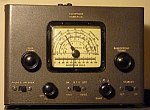 My World War Two era EC-1 If you would like to read about how I restored a radio salvaged from a trash pile 50 years ago, perhaps you'd like to read about 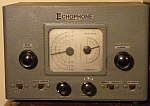 The EC-1b Radio from Captain Allan Hancock's Flying Field or maybe you would like to read about the line of Hallicrafters radios that replaced the EC-1s and preceded the S-120 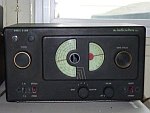 My S-38b radio I have written a little essay you might like that explains some of the principles behind 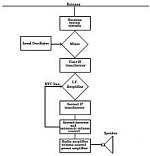 How The Armstrong Superheterodyne Radio Works or perhaps you'd like to read a story about another old radio or an essay from  My radio article selection page As a last resort, you can Return to my Home Page |
